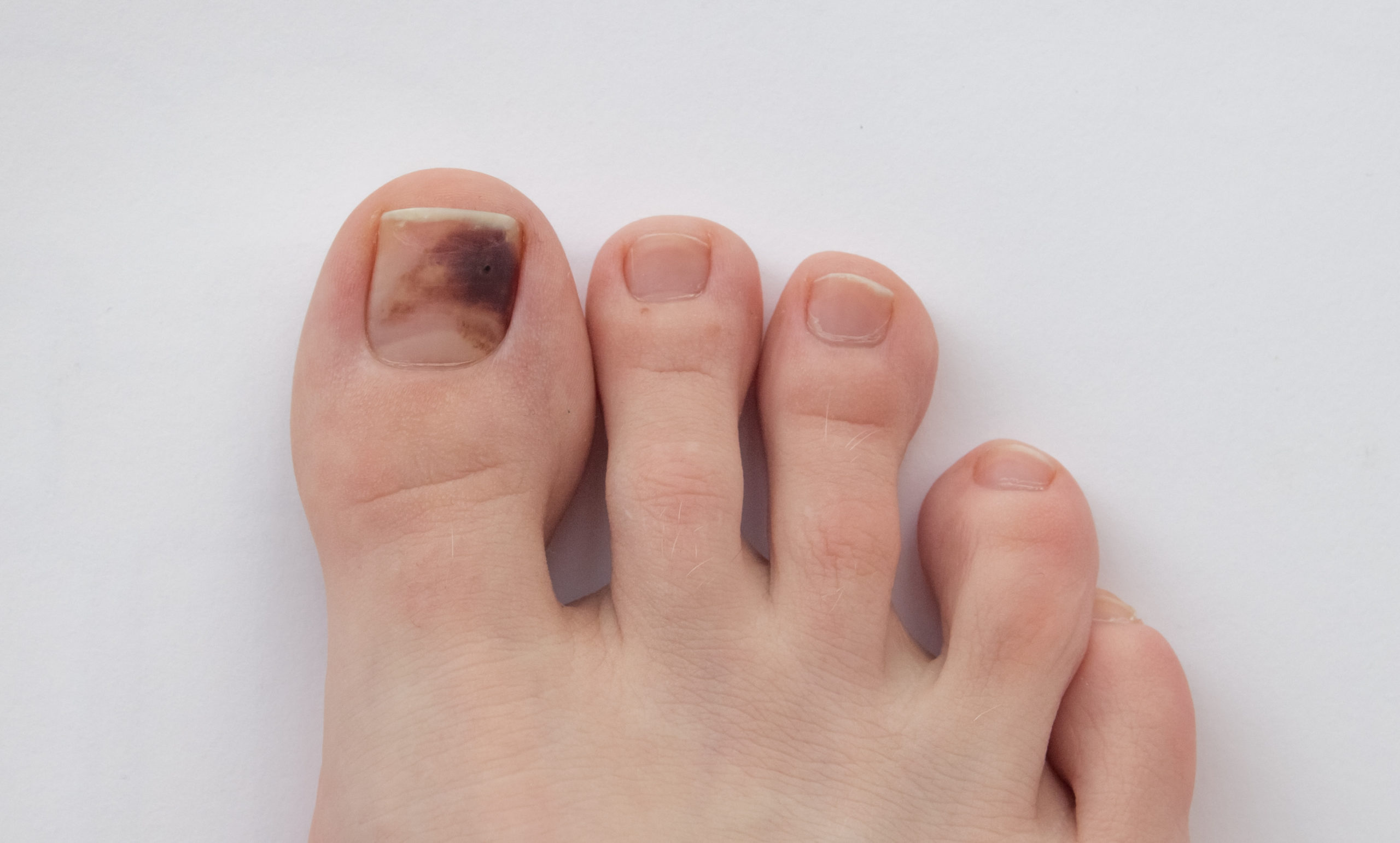

As having black spots beneath our toenails is far from the norm for most people, it’s not surprising that they can ring alarm bells and cause concern. Especially when we think back to favourites like Bob Marley who passed away at age 36 from a melanoma (which appears like a dark patch under the nail) that started beneath his toenail.
The truth is that there are a variety of causes for dark spots beneath the nails. Most of these aren’t pretty to look at, some of these can be associated with discomfort or ongoing problems, some are harmless, and in the least common but most extreme cases, some may be a sign of cancer.
To help, your My FootDr podiatry team have shared the top six causes of black spots beneath the toenails.
1. Blood Beneath The Nail
This is what we call a subungual haematoma which translates to blood beneath the nail. There are many reasons why you may get bleeding beneath the nail, and before you worry, most of these are harmless and comparable to getting bruising beneath your skin.
Examples include impact injury, like having your toe stood on in sports or dropping something heavy on your foot, stubbing your toe, wearing tight shoes that press on your toes, keeping your nails too long so that they’re constantly buttressing against the end of the shoe, and the like.
Depending on the size of the bleeding and the spot, you may lose your toenail. If this happens, it’s likely that the nail will simply grow back with little harm done, though as toenails grow slowly, it may take anywhere from 9-18 months.

2. Toenail Fungus
While we traditionally know and recognise fungal nail infections as having a yellow discolouration, it may also be green, brown and black, too. You may distinguish toenail fungus from other causes of black discolouration by looking for other common features like brittle, crumbly or thickened nails.
Again, fungal nail infections are not a cause for alarm bells, but they do require treatment to stop the infection from spreading to your other toes, and to others within your household. We highly recommend using anti-fungal laser to treat fungal nail infections as it has superior effectiveness over traditional methods like creams, lacquers, powders and tablets.
3. Bacterial Infection
Specifically speaking, we’re talking about a pseudomonas bacterial infection. Unlike nail fungus which often doesn’t pose any immediate dangers to our health, bacterial infections require immediate treatment because of the way they affect our bodies and put us at risk of the infection entering our bloodstream – which is when things can get very serious, very quickly.
If you have this bacterial infection, it can pop up quite quickly to produce green-black discolouration on the nail. You’ll likely have a pungent smell coming from the feet, which may almost smell sweet. As this bacteria has a preference for moist environments, particularly the muddy outdoors, you may be a regular swimmer or have recently completed a hike or tramp.
You may also have a condition like psoriasis that originally caused damage to the nail, allowing the bacteria to penetrate and take hold more easily. Regardless of how it came to be, it’s important that you have this infection treated immediately.
4. Medical Conditions
Sometimes, black discolouration is a side-effect of other conditions like diabetes, kidney problems, heart disease and anaemia, to name a few. If that’s the case, managing the discolouration relies heavily on managing the original problem effectively.
If your GP or specialist doesn’t already know about the discolouration linked to your other medical conditions, make sure you tell them at your next appointment so they can keep any eye on the progression – it can often be a handy indication on how your treatments are going.
5. Melanoma (Skin Cancer)
We had to get to this one eventually, right? There’s always a chance that the black spot beneath your nail is actually a mole, and that the mole may be a malignant melanoma, which is a dangerous and severe form of skin cancer. It may appear as a round black mole, or it may appear as a streak in the nail – which is what it did for Bob Marley.
Melanomas aren’t typically painful or symptomatic, so it’s really important to let everyone know about it – your podiatrist, your GP, your skin specialist – and keep a close eye on it yourself. If you’re worried about a melanoma, definitely avoid painting the nail so you can monitor for any changes, like in shape and pigmentation, and signs that it’s getting bigger.
Over time, it may cause discolouration and changes in the areas surrounding it too. Melanomas are not something you want to take a chance with or ignore and hope for the best. You must have it seen to immediately.
6. It’s Your Nail Polish
Ending with our least concerning cause – for many people, wearing dark nail polishes over time can discolour their nails. Usually, it only affects the top layer of the nail and doesn’t affect the area beneath the nail at all. Which is great news as in most cases, we’re able to use a nail burr to immediately remove that top discoloured layer and fix the problem! Just book in for one of our nail care appointments.
Concerned About What You’re Seeing?
Nail problems should never have you worried or keep you awake at night – and if they are, we highly recommend trusting those instincts and having your nails checked. Our podiatry team will give you an idea of what the likely cause for your nail discolouration is and treat it accordingly – or refer you to a specialist if we suspect something more sinister or further investigation is required.
Book your appointment online here or call us on 1800 FOOTDR


